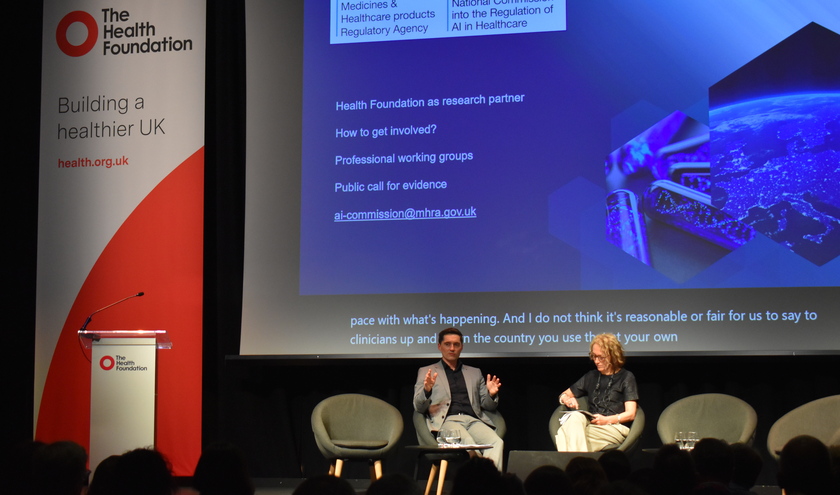Regulation, implementation and scaling, workforce development, lessons from international adoption and public engagement were the leading themes at The Health Foundation's AI in the NHS 2025 event in King's Cross, London on Tuesday, 14 October.
Dr Zubir Ahmed, Parliamentary under-secretary of state, DHSC, opened the conference highlighting four areas where AI can be harnessed in healthcare.
The first area cited by Dr Ahmed was direct patient care.
He illustrated the Government's commitment to half a million robotic-assisted procedures by 2035 and the ability of AI-powered wearables in allowing patients and clinicians the ability to monitor conditions in the home.
Secondly, Dr Ahmed highlighted supportive and non-clinical activities such as ambient voice technologies, promising updated guidance on safe adoption ‘in the very, very near future'.
Thirdly, the minister said there was a ‘great opportunity to use all sorts of AI to improve public health' citing the example of how datasets and machine learning can be used to break down barriers between an ethnically and socially diverse population.
Finally, Dr Ahmed described how life sciences were applying AI to health datasets to improve clinical trial design and patient recruitment, discover and develop new drugs, and personalise medicines for patients.
Workforce
Dr Ahmed said AI ‘can only succeed if our workforce is engaged, equipped, and confident that technology is finally going to deliver on its purported promise'.
He stressed that means ‘investing in digital engagement and literacy at every level, and in every profession', and embedding AI and data skills into continuous professional development'.
The minister said the Government needed leaders ‘who champion innovation'.
He added: ‘We must keep our workforce engaged, actively participating in the journey to help the NHS transform into an AI-ready and enabled health service.'
Alec Price-Forbes, national chief clinical information officer, NHS England said: ‘We know that only 11% of staff tell us that they have the sort of equipment and tools to be able to do their job and for 70% interoperability is a challenge around integrated care.'
Regulation
MHRA chief executive Lawrence Tallon stressed ‘the regularity framework is going to have come up a level because the technology is moving so quickly' and pledged an overarching framework ideally by the middle of 2026.
The chief executive said guidance would have to be brought forward around ‘hot topics' such as ambient voice scribe and discharge summaries.
A National Commission into the Regulation of AI in Healthcare to review current regulations and provide recommendations for a new regulatory framework for AI in healthcare was established on 26 September.
International adoption
The conference explored international learning and experience about how to capitalise on AI in healthcare and discussed how different countries are navigating the key challenges involved, with contributions from leaders in Norway, Spain and Estonia.
Dr Joan Guanyabens, director, TIC Salut i Social Foundation, Spain, said: ‘We have learned from the very beginning to put in the correct leadership.
‘That means putting clinicians at the front because they can see all the difficulties that you have to afford in evaluation, adoption, capacity, etc, to be successful.'
Dr Guanyabens said Catalonia had set up an AI observatory to monitor the application of patient algorithms.
‘It could be useful to fullfil a European requirement that any citizen has the right to know that the system is using an algorithm to take care of them,' he said.
Public engagement
Price-Forbes highlighted the importance of creating a transparent culture where ‘we can bring the public, as well as the workforce and patients on that journey of discovery'.
The chief clinical information officer highlighted the huge scale of the national challenge ahead in England where 7% of the public don't have the internet and 10m people are digitally illiterate.
‘There's huge amounts we need to be able to do, not just embedding those skills within workforce, but I would say wider society,' he commented.
‘This is about the public, as well as patients, advocates and the workforce.'



